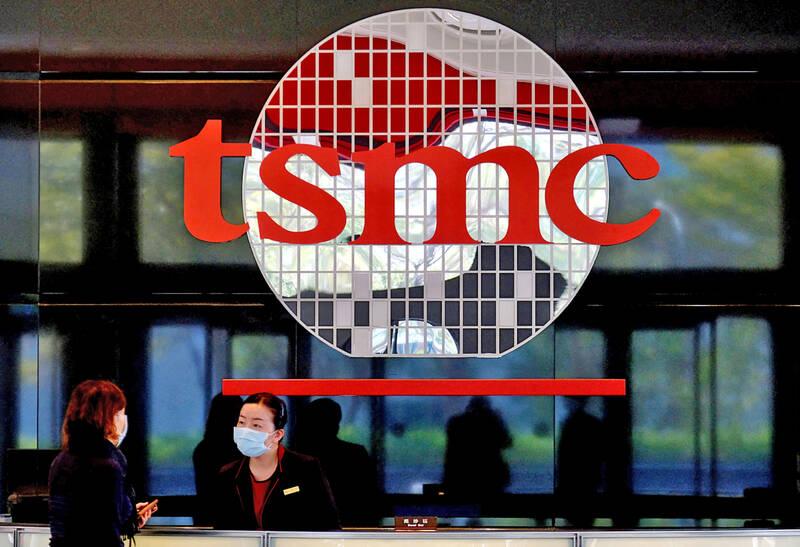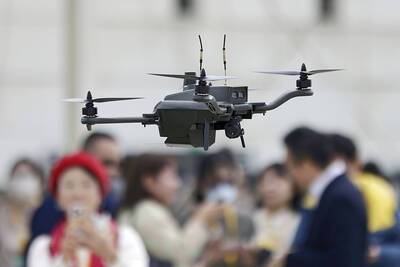Taiwan Semiconductor Manufacturing Co (TSMC, 台積電) would not produce its most advanced chips in the US next year, Minister of Economic Affairs J.W. Kuo (郭智輝) said today, after the company announced plans to invest another US$100 billion in US semiconductor manufacturing over the next four years.
US President Donald Trump and TSMC chairman C.C. Wei (魏哲家) yesterday announced that TSMC would invest in three new chip fabs, two advanced packaging plants and a research and development center in the US during a meeting at the White House.
By investing in the US, TSMC could avoid paying high tariffs, Trump said.

Photo: Sam Yeh, AFP
TSMC is already investing US$65 billion in Arizona to build three advanced wafer fabs.
The first fab in Arizona has started production using the 4-nanometer (nm) process, while the second fab, which is to be using the more sophisticated 3nm, 2nm and A16 processes, is currently under construction and is expected to begin production in 2028.
The third, of which TSMC has said little to date, is expected to begin production by 2030 using 2nm or more advanced processes, TSMC said in April last year.
Answering questions from lawmakers this morning, Kuo said “it would be impossible” for TSMC’s 2nm and 1.6nm chips to be produced in the US next year.
All overseas investments are subject to review, but approval of the TSMC deal is 99.9 percent certain, Kuo said in response to concern about whether the Department of Investment Review would find issues with the deal.
The government has been working with its allies to maintain peace and stability in the Asia-Pacific region, and any disruption to Taiwan would affect the entire world, including China, Premier Cho Jung-tai (卓榮泰) said.
Therefore, regardless of overseas investments and industrial expansion, Taiwan must continue to be a world leader in manufacturing, Cho added.
The government first heard that the deal was finalized in yesterday’s official announcement, but it maintained close and effective communication with TSMC regarding the project beforehand, Cho said.
Speaking to reporters before the session, Cho said that the plan aligns with Taiwan’s core principle of strengthening domestic industries while expanding its global presence.
The government wholeheartedly endorses initiatives that promote Taiwan’s key position in the global semiconductor supply chain and increase the competitiveness of Taiwanese chips, Cabinet spokesperson Michelle Lee (李慧芝) said in a news release.
The government would first conduct a thorough legal review into TSMC’s plans to ensure the development of the company and Taiwan’s semiconductor industry, she said.
The US is Taiwan’s most important trading partner and the two have cooperated for many years in the science and technology industry, boosting the economy and providing countless employment opportunities on both sides of the Pacific, she added.
Since Trump’s first term in office, Taiwan has been shifting investments stateside, with the US becoming Taiwan’s top outbound investment destination, constituting 30 percent of Taiwan’s foreign investments last year while investment in China has declined, she said.
Presidential Office spokesperson Karen Kuo (郭雅慧) said the government knew about the deal in advance and would assist.
It would also “ensure that the most advanced processes stay in Taiwan,” she added.

The combined effect of the monsoon, the outer rim of Typhoon Fengshen and a low-pressure system is expected to bring significant rainfall this week to various parts of the nation, the Central Weather Administration (CWA) said. The heaviest rain is expected to occur today and tomorrow, with torrential rain expected in Keelung’s north coast, Yilan and the mountainous regions of Taipei and New Taipei City, the CWA said. Rivers could rise rapidly, and residents should stay away from riverbanks and avoid going to the mountains or engaging in water activities, it said. Scattered showers are expected today in central and

COOPERATION: Taiwan is aligning closely with US strategic objectives on various matters, including China’s rare earths restrictions, the Ministry of Foreign Affairs said Taiwan could deal with China’s tightened export controls on rare earth metals by turning to “urban mining,” a researcher said yesterday. Rare earth metals, which are used in semiconductors and other electronic components, could be recovered from industrial or electronic waste to reduce reliance on imports, National Cheng Kung University Department of Resources Engineering professor Lee Cheng-han (李政翰) said. Despite their name, rare earth elements are not actually rare — their abundance in the Earth’s crust is relatively high, but they are dispersed, making extraction and refining energy-intensive and environmentally damaging, he said, adding that many countries have opted to

SUPPLY CHAIN: Taiwan’s advantages in the drone industry include rapid production capacity that is independent of Chinese-made parts, the economic ministry said The Executive Yuan yesterday approved plans to invest NT$44.2 billion (US$1.44 billion) into domestic production of uncrewed aerial vehicles over the next six years, bringing Taiwan’s output value to more than NT$40 billion by 2030 and making the nation Asia’s democratic hub for the drone supply chain. The proposed budget has NT$33.8 billion in new allocations and NT$10.43 billion in existing funds, the Ministry of Economic Affairs said. Under the new development program, the public sector would purchase nearly 100,000 drones, of which 50,898 would be for civil and government use, while 48,750 would be for national defense, it said. The Ministry of

UNITED: The other candidates congratulated Cheng on her win, saying they hoped the new chair could bring the party to victory in the elections next year and in 2028 Former Chinese Nationalist Party (KMT) lawmaker Cheng Li-wun (鄭麗文) yesterday won the party’s chair election with 65,122 votes, or 50.15 percent of the votes. It was the first time Cheng, 55, ran for the top KMT post, and she is the second woman to hold the post of chair, following Hung Hsiu-chu (洪秀柱), who served from 2016 to 2017. Cheng is to succeed incumbent Eric Chu (朱立倫) on Nov. 1 for a four-year term. Cheng said she has spoken with the other five candidates and pledged to maintain party unity, adding that the party would aim to win the elections next year and